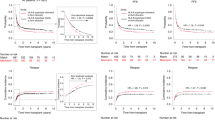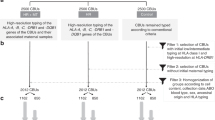Abstract
The feasibility of selecting cord blood (CB) units at high-resolution HLA match has not been investigated. We analyzed the high-resolution donor–recipient HLA match of 100 double-unit 4–6/6 HLA-A,-B antigen, -DRB1 allele-matched CB grafts (units 1a and 1b) and their back-up units (n=377 units in total). The median cryopreserved graft dose was 2.9 × 107/kg/unit, and at high resolution these units had a median donor–recipient HLA-allele match of 5/8 (range 2–8/8) and 6/10 (range 2–9/10), respectively. We then evaluated how often use of high-resolution HLA-match criteria would change the original graft selection to substitute one or both of the back-up units for units 1a and/or 1b. On using a model in which both a higher eight-allele HLA match and a cell dose ⩾2.0 × 107/kg/unit were required, graft selection changed in 33% of transplants with minimal effect on cell dose (8.3% reduction). In summary, while units chosen based on HLA-A,-B antigen and -DRB1 allele match have substantial mismatch at higher resolution, CB selection based on high-resolution HLA match is possible in a significant proportion of patients without compromise in cell dose.
This is a preview of subscription content, access via your institution
Access options
Subscribe to this journal
Receive 12 print issues and online access
$259.00 per year
only $21.58 per issue
Buy this article
- Purchase on Springer Link
- Instant access to full article PDF
Prices may be subject to local taxes which are calculated during checkout

Similar content being viewed by others
References
Kogler G, Enczmann J, Rocha V, Gluckman E, Wernet P . High-resolution HLA typing by sequencing for HLA-A, -B, -C, -DR, -DQ in 122 unrelated cord blood/patient pair transplants hardly improves long-term clinical outcome. Bone Marrow Transplant 2005; 36: 1033–1041.
Kurtzberg J, Prasad VK, Carter SL, Wagner JE, Baxter-Lowe LA, Wall D et al. Results of the Cord Blood Transplantation Study (COBLT): clinical outcomes of unrelated donor umbilical cord blood transplantation in pediatric patients with hematologic malignancies. Blood 2008; 112: 4318–4327.
Eapen M, Klein JP, Sanz GF, Spellman S, Ruggeri A, Anasetti C et al. Effect of donor-recipient HLA matching at HLA A, B, C, and DRB1 on outcomes after umbilical-cord blood transplantation for leukaemia and myelodysplastic syndrome: a retrospective analysis. Lancet Oncol 2011; 12: 1214–1221.
Eapen M, Klein JP, Ruggeri A, Spellman S, Lee SJ, Anasetti C et al. Impact of allele-level HLA matching on outcomes after myeloablative single unit umbilical cord blood transplantation for hematologic malignancy. Blood 2014; 123: 133–140.
Ponce DM, Gonzales A, Lubin M, Castro-Malaspina H, Giralt S, Goldberg JD et al. Graft-versus-host disease after double-unit cord blood transplantation has unique features and an association with engrafting unit-to-recipient HLA match. Biol Blood Marrow Transplant 2013; 19: 904–911.
Eapen M, Rubinstein P, Zhang MJ, Stevens C, Kurtzberg J, Scaradavou A et al. Comparison of outcomes after transplantation of unrelated donor umbilical cord blood and bone marrow in children with acute leukemia. Lancet 2007; 369: 1947–1954.
Eapen M, Rocha V, Sanz G, Scaradavou A, Zhang MJ, Arcese W et al. Effect of graft source on unrelated donor haemopoietic stem-cell transplantation in adults with acute leukaemia: a retrospective analysis. Lancet Oncol 2010; 11: 653–660.
Brunstein CG, Gutman JA, Weisdorf DJ, Woolfrey AE, Defor TE, Gooley TA et al. Allogeneic hematopoietic cell transplantation for hematological malignancy: relative risks and benefits of double umbilical cord blood. Blood 2010; 116: 4693–4699.
Brunstein CG, Fuchs EJ, Carter SL, Karanes C, Costa LJ, Wu J et al. Alternative donor transplantation after reduced intensity conditioning: results of parallel phase 2 trials using partially HLA-mismatched related bone marrow or unrelated double umbilical cord blood grafts. Blood 2011; 118: 282–288.
Ponce DM, Zheng J, Gonzales AM, Lubin M, Heller G, Castro-Malaspina H et al. Reduced late mortality risk contributes to similar survival after double-unit cord blood transplantation compared with related and unrelated donor hematopoietic stem cell transplantation. Biol Blood Marrow Transplant 2011; 17: 1316–1326.
Brunstein CG, Eapen M, Ahn KW, Appelbaum FR, Ballen KK, Champlin RE et al. Reduced-intensity conditioning transplantation in acute leukemia: the effect of source of unrelated donor stem cells on outcomes. Blood 2012; 119: 5591–5598.
Barker JN, Byam C, Scaradavou A . How I treat: the selection and acquisition of unrelated cord blood grafts. Blood 2011; 117: 2332–2339.
Ponce DM, Lubin M, Gonzales AM, Byam C, Wells D, Ferrante R et al. The use of back-up units to enhance the safety of unrelated donor cord blood transplantation. Biol Blood Marrow Transplant 2012; 18: 648–651.
Stevens CE, Carrier C, Carpenter C, Sung D, Scaradavou A . HLA mismatch direction in cord blood transplantation: impact on outcome and implications for cord blood unit selection. Blood 2011; 118: 3969–3978.
Acknowledgements
This work was supported in part by the Gabrielle’s Angel Foundation for Cancer Research, the Memorial Sloan-Kettering Cancer Center Society, the Translational and Integrative Medicine Research Grant and P01 CA23766 from the National Cancer Institute, National Institutes of Health.
Author information
Authors and Affiliations
Corresponding author
Ethics declarations
Competing interests
The authors declare no conflict of interest.
Rights and permissions
About this article
Cite this article
Dahi, P., Ponce, D., Devlin, S. et al. Donor–recipient allele-level HLA matching of unrelated cord blood units reveals high degrees of mismatch and alters graft selection. Bone Marrow Transplant 49, 1184–1186 (2014). https://doi.org/10.1038/bmt.2014.135
Received:
Revised:
Accepted:
Published:
Issue Date:
DOI: https://doi.org/10.1038/bmt.2014.135



